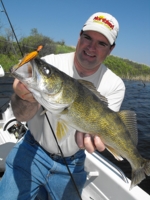Slow and Easy for Spring Walleye
Category: article
Jan 31st, 2011 by OutdoorsFIRST
Modified Jan 31st, 2011 at 12:00 AM
So often when targeting big walleyes early in the season, less is more. The most productive techniques are often simple and subtle. On natural lakes in particular, we often find fish shallow, relating to the shoreline. Good locations might include protected shallow bays or shallow gravel and sand flats that warm up relatively quickly during the spring. On many bodies of water, water clarity is often generally clear and as the water warms up, the water tends to stain up. The exception would be strong run off or wind.
Clear water that hasn’t had a chance to warm up requires some adjustments to consistently catch fish. We often find some of the largest fish in less than five feet of water during this time frame but water clarity can narrow the windows of opportunity. When the sun is out early in the season, we often find big fish in shallow water even though the water is clear enough to distinguish the bottom and these fish can be extremely difficult with no overcast or wind. The fish are still often active but are hard to approach. The sweet spot is often just past the depth where you can physically see the bottom for numbers of fish. Some prime opportunities however often occur much shallow after dark or during sunrise or sunset.
 |
|
When the water is still cold and relatively clear, we seem to catch many more fish by using monofilament line. Monofilament disappears in the water better than braid and for many of these presentations; I avoid using fluorocarbon because the sinking characteristics speed up the presentation too fast. What might be the biggest advantage to using monofilament for these presentations might be the stretch and subtleness of the line which seems to subdue and soften the swimming motion on the jig. The jig seems to have a more fluid, do nothing swim and glide through the water that really seems to trigger these fish. The top monofilament line that many walleye anglers have begun using is the Northland Bionic Walleye Line and the blue camo color works extremely well because the line can be watched much easier. For clean bottoms and open water, I love the five pound test. For heavier rock and debris, the eight pound works really well.
The nuts and bolts of this presentation is making long casts across these shallow flats and simply swimming the jig. Very few hops or pops, just cast and reel slow. If you start ticking the bottom, you are reeling too slowly. You want the jig to just glide along just off the bottom. Traditional jig combinations include the classic Fireball jig tipped with either a minnow, half crawler or leech and these combinations have caught a tremendous number of walleyes but the long casts often tear bait off. Many anglers have started to switch over to soft plastics or gone back classic buck tail or marabou dressings.
The most effective soft plastic jig for me over the past handful of years has been the Northland Mimic Minnow which has a pointed jig head that swims and tracks through the water nice. The body is long with a paddle which makes a nice thump as it is retrieved through the water. If the fish won’t hit the Mimic Minnow or bumping the bait short, I have had good luck with the Trigger X soft plastics. These synthetic water soluble baits are really soft and have a deadly action and the scent really seems to help in cold water.
Years ago, many walleye anglers cut their teeth on buck tail and marabou jigs but over the years, some anglers begin to forget how effective these dressings can be on a jig. Plastics today are scented and have more action and really replaced hair or marabou but some anglers are going back to the traditional dressings. Both buck tail hair and marabou is much more subtle in the water. The action is minute and the jig basically glides through the water in a straight line but this lack of vibration and flash can be extremely deadly early in the season. This is basically a do nothing jig that looks like a minnow swimming in a straight line and often, that is exactly what a walleye wants early in the season. Later in the season, we pop and snap these jigs back to the boat but I encourage you to try the simple cast and slow reel technique with jigs in conjunction with plastics, hair and marabou. So often in the spring, less is more. Slow and steady retrieves across shallow water early in the year often account for several trophy fish for us each year.